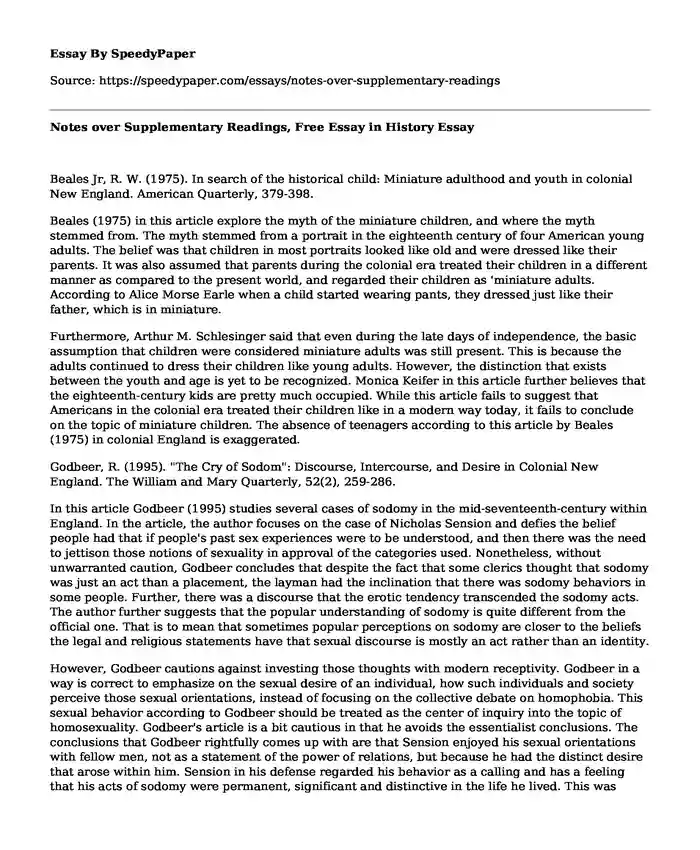Beales Jr, R. W. (1975). In search of the historical child: Miniature adulthood and youth in colonial New England. American Quarterly, 379-398.
Beales (1975) in this article explore the myth of the miniature children, and where the myth stemmed from. The myth stemmed from a portrait in the eighteenth century of four American young adults. The belief was that children in most portraits looked like old and were dressed like their parents. It was also assumed that parents during the colonial era treated their children in a different manner as compared to the present world, and regarded their children as 'miniature adults. According to Alice Morse Earle when a child started wearing pants, they dressed just like their father, which is in miniature.
Furthermore, Arthur M. Schlesinger said that even during the late days of independence, the basic assumption that children were considered miniature adults was still present. This is because the adults continued to dress their children like young adults. However, the distinction that exists between the youth and age is yet to be recognized. Monica Keifer in this article further believes that the eighteenth-century kids are pretty much occupied. While this article fails to suggest that Americans in the colonial era treated their children like in a modern way today, it fails to conclude on the topic of miniature children. The absence of teenagers according to this article by Beales (1975) in colonial England is exaggerated.
Godbeer, R. (1995). "The Cry of Sodom": Discourse, Intercourse, and Desire in Colonial New England. The William and Mary Quarterly, 52(2), 259-286.
In this article Godbeer (1995) studies several cases of sodomy in the mid-seventeenth-century within England. In the article, the author focuses on the case of Nicholas Sension and defies the belief people had that if people's past sex experiences were to be understood, and then there was the need to jettison those notions of sexuality in approval of the categories used. Nonetheless, without unwarranted caution, Godbeer concludes that despite the fact that some clerics thought that sodomy was just an act than a placement, the layman had the inclination that there was sodomy behaviors in some people. Further, there was a discourse that the erotic tendency transcended the sodomy acts. The author further suggests that the popular understanding of sodomy is quite different from the official one. That is to mean that sometimes popular perceptions on sodomy are closer to the beliefs the legal and religious statements have that sexual discourse is mostly an act rather than an identity.
However, Godbeer cautions against investing those thoughts with modern receptivity. Godbeer in a way is correct to emphasize on the sexual desire of an individual, how such individuals and society perceive those sexual orientations, instead of focusing on the collective debate on homophobia. This sexual behavior according to Godbeer should be treated as the center of inquiry into the topic of homosexuality. Godbeer's article is a bit cautious in that he avoids the essentialist conclusions. The conclusions that Godbeer rightfully comes up with are that Sension enjoyed his sexual orientations with fellow men, not as a statement of the power of relations, but because he had the distinct desire that arose within him. Sension in his defense regarded his behavior as a calling and has a feeling that his acts of sodomy were permanent, significant and distinctive in the life he lived. This was contrary to the view that the official discourse had on the acts of sodomy.
References
Beales Jr, R. W. (1975). In search of the historical child: Miniature adulthood and youth in colonial New England. American Quarterly, 379-398.
Godbeer, R. (1995). "The Cry of Sodom": Discourse, Intercourse, and Desire in Colonial New England. The William and Mary Quarterly, 52(2), 259-286.
Cite this page
Notes over Supplementary Readings, Free Essay in History. (2022, Mar 23). Retrieved from https://speedypaper.net/essays/notes-over-supplementary-readings
Request Removal
If you are the original author of this essay and no longer wish to have it published on the SpeedyPaper website, please click below to request its removal:
- My Handover of Corporate Recruitment Division - HRM Essay Sample
- Event Analysis Essay, Free Example for Everyone
- Big Mama - Movie Review Essay Example
- Cochrane - Article Review Essay Example
- Gender Roles in Moll Flanders by Daniel Defoe
- Free Essay Answering How Does Greek Financial Crisis Influence EU Economy Over Time
- Independent Policies Essay Sample
Popular categories





